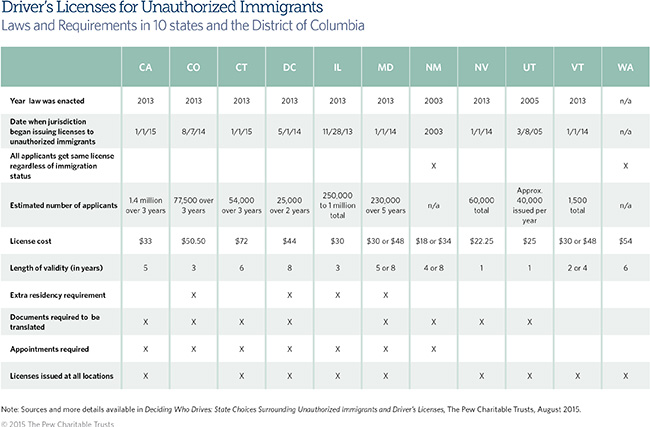Deciding Who Drives
State choices surrounding unauthorized immigrants and driver’s licenses
Ten states and the District of Columbia issue driver’s licenses to unauthorized immigrants.
Each of these 11 jurisdictions (California, Colorado, Connecticut, the District of Columbia, Illinois, Maryland, Nevada, New Mexico, Utah, Vermont, and Washington) has taken its own path to enact and implement a law that allows unauthorized immigrants to obtain driver’s licenses. There are many similarities in their approaches but also some critical differences. New Mexico and Washington issue the same license to all applicants, regardless of immigration status, while eight other states and the District of Columbia issue distinctive licenses—referred to by a variety of names—to those who do not have explicit permission from the U.S. government to reside in the country. Decisions at various points in the legislative or regulatory processes, or during implementation, affect how these laws work and what impact they have. In 2015, Delaware and Hawaii enacted laws to allow unauthorized immigrants to obtain driver’s licenses, but they have not yet begun issuing them. Policymakers in these two states and others considering similar legislation can gain insights from the experiences of jurisdictions that have these laws.
Lessons learned
An analysis by Pew found wide variation in the choices that jurisdictions made to provide licenses to unauthorized immigrants. The report identifies eight key takeaways across four main categories of decisions that are critical to putting these policies in place. The main categories are:
- Estimating scope, including the size of the target population and the anticipated cost and revenue of expanding licensing to a new group of people.
- Setting eligibility standards and determining which documents will be accepted as proof of meeting them.
- Creating issuance procedures to serve the public and address potential fraud.
- Providing outreach and information to potential applicants.
Pew’s analysis did not examine the factors contributing to states’ decisions to issue licenses to unauthorized immigrants or the merits of those decisions, nor does Pew take a position on this issue.
Scope
States estimate how many people will be eligible, how many will apply, and how often they will need to renew their licenses. These estimates are critical in determining the expected cost of implementation and the amount of revenue likely to be generated from new customers.
- Key takeaway 1. Consulting multiple sources of data, examining other states’ experiences, and making multiyear projections help to assess demand and allocate resources over time.
- Key takeaway 2. Estimating and planning for startup costs help ensure that issuing agencies can implement the law effectively before they receive fee revenue.
- Key takeaway 3. Budgeting for the necessary staff and technology systems is important; states can first explore ways to reduce costs by adapting existing systems before designing completely new ones.
Eligibility standards
States determine who is eligible to obtain a driver’s license and which documents the applicants can use to prove eligibility. Because unauthorized immigrants may not have the same types of documents as U.S. citizens or lawfully present immigrants, states make choices about what they will accept as proof of identity and state residency.
- Key takeaway 4. Working with foreign consulates, community organizations, and other experts can help states determine which documents unauthorized immigrants commonly hold and how to verify their authenticity.
- Key takeaway 5. Considering which foreign-issued documents—or which portions of them—require translation and who is authorized to provide translation services is critical when accepting documents in other languages.
Issuance procedures
States need to make choices about the application and renewal processes for alternative licenses. Issuing agencies are likely to experience spikes in new applicants while continuing to provide services to existing customers.
- Key takeaway 6. Creating appointment systems can help manage the flow of applicants and provide a means to communicate requirements so that applicants arrive prepared. States also need to be able to handle the demand for appointments, monitor scheduled appointments for potential problems, and resolve issues that arise.
- Key takeaway 7. Processes for handling applicants who have used fraudulent documents to obtain driver’s licenses in the past should be considered. Current fraud procedures may be adequate, or issuing agencies may need separate systems for alternative license applicants.
Outreach and education
Potential applicants need information about eligibility and document requirements as well as application and testing procedures. Ensuring that applicants are adequately prepared for their first visit reduces the burden of repeat visits.
- Key takeaway 8. Proactively educating and informing target populations are critical to their awareness and preparedness. Issuing agencies can work with trusted community-based organizations and produce culturally and linguistically appropriate materials to extend their reach into immigrant communities.
Why this matters
In upcoming legislative sessions, more states are likely to consider whether to allow unauthorized immigrants to obtain driver’s licenses, while some that already do may consider making changes to their laws. These decisions unfold in the context of the federal REAL ID Act, the 2005 law that created national standards for driver’s licenses and provided parameters for licensing unauthorized immigrants.
State decisions also are likely to be affected by federal executive actions that, if fully implemented, could allow millions of unauthorized immigrants who meet certain conditions to obtain the documents needed to apply for regular driver’s licenses under existing state laws. All of these factors will affect the choices that states make about providing driver’s licenses to unauthorized immigrants.












